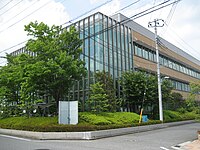Midori-ku, Saitama
|
Midori-ku, Saitama 緑区 |
|
|---|---|
| Ward | |
| Midori Ward | |

Midori Ward Office, Saitama City
|
|
 Location of Midori-ku in Saitama |
|
| Coordinates: 35°52′15.9″N 139°41′2.7″E / 35.871083°N 139.684083°ECoordinates: 35°52′15.9″N 139°41′2.7″E / 35.871083°N 139.684083°E | |
| Country | Japan |
| Region | Kanto |
| Prefecture | Saitama |
| City | Saitama |
| Area | |
| • Total | 26.44 km2 (10.21 sq mi) |
| Population (February 2016) | |
| • Total | 117,152 |
| • Density | 4,430/km2 (11,500/sq mi) |
| Time zone | Japan Standard Time (UTC+9) |
| - Tree | Sakura |
| -Flower | Cornus florida |
| -Bird | Egret |
| Phone number | 048-835-3156 |
| Address |
975-1 Oji-Nakao Midori-ku, Saitama-shi, Saitama-ken 374-1111 338-0002 |
| Website | www |
975-1 Oji-Nakao Midori-ku, Saitama-shi, Saitama-ken 374-1111
Midori-ku (緑区 Midori-ku?) is one of ten wards of the city of Saitama, in Saitama Prefecture, Japan, and is located in the southeastern part of the city. As of 1 February 2016[update], the ward had an estimated population of 117,152 and a population density of 4,430 persons per km². Its total area was 26.44 square kilometres (10.21 sq mi).
A wide area of green farmland, Minuma Rice Paddies, forms the central part of the ward. The major river system includes the Shiba River, the Ayanose River, and the Minuma Irrigational Canal. In the southern section of the ward runs the Tōhoku Expressway.
Saitama Prefecture
The first people who stayed permanently in this area are considered to have arrived approximately twenty five thousand years ago. Paleolithic archaeological sites found in the area include Matsuki (松木?), Wadakita (和田北?), Kitajukunishi (北宿西?), and Mamiya Miyaushiro (間宮宮後?). In the early modern period, the area witnessed large-scale civil engineering projects: the construction of the Minuma Reservoir (見沼溜井 Minuma Tamei?), the demolition of the reservoir, and the creation of the Minuma Irrigational Canal (見沼代用水 Minumadai Yōsui?). Daimon-shuku (大門宿?) became one of the post stations of the Nikkō Onari Kaidō.
...
Wikipedia

